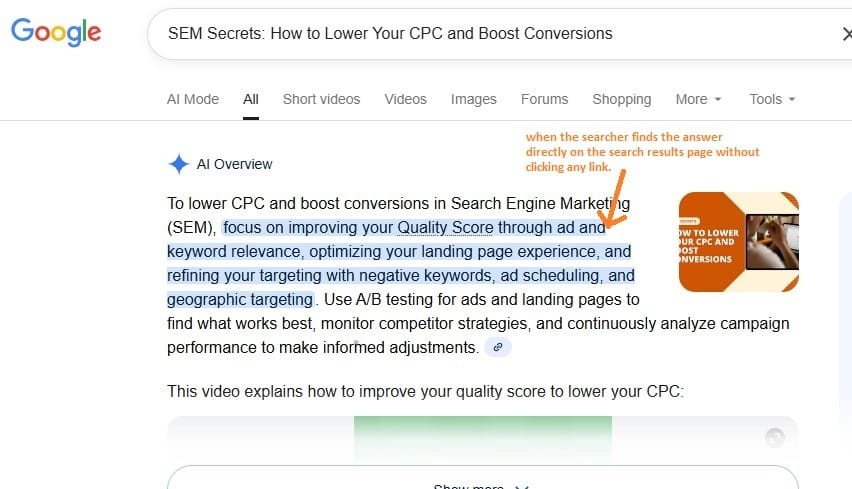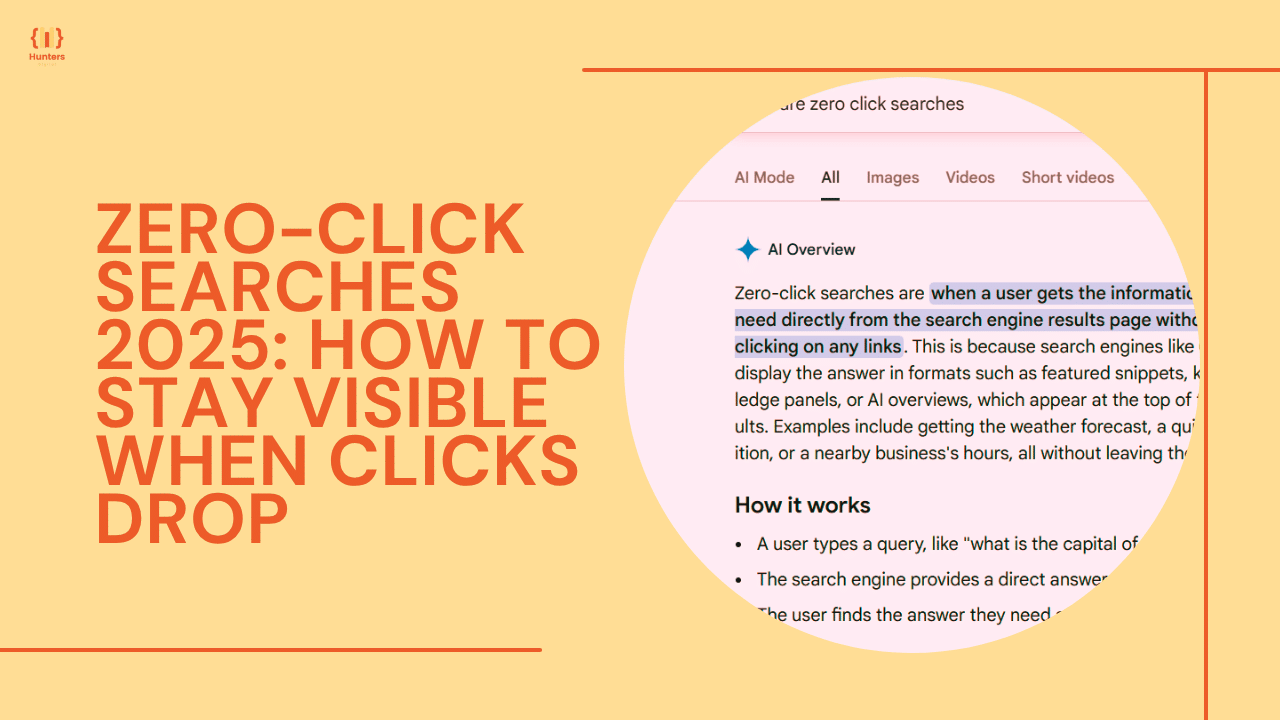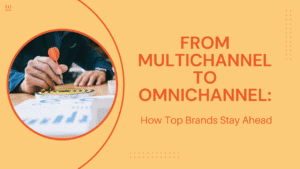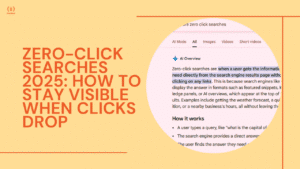Ever searched something on Google and got your answer right there — no clicks needed? That’s a zero-click search. In 2025, these instant answers dominate Google results, giving users quick info while cutting traffic to websites.
It’s not that people don’t want to visit sites — it’s that Google’s doing the heavy lifting. From featured snippets to AI summaries and voice results, search is faster than ever.
So, the real question for marketers and business owners is: how do you stay visible when clicks are disappearing?
But here’s the truth: zero-click searches aren’t killing SEO. It’s just evolving. Let’s explore how to adapt, stand out, and stay seen in a world where clicks are no longer the main goal.
What Are Zero-Click Searches?

A zero-click search occurs when the searcher finds the answer directly on the search results page without clicking any link. Google’s rich features — like featured snippets, knowledge panels, People Also Ask boxes, and local packs — now deliver instant answers.
Think about this:
- You search “how many calories in a banana?”
- Google displays a quick answer right under the search bar.
- You don’t need to click any site because you’ve already got your answer.
That’s a zero-click search in action.
How Zero-Click Searches Work
Let’s break this down simply. Zero-click searches happen because Google wants to answer a user’s question as directly as possible. Here’s what that looks like on a typical SERP (Search Engine Results Page):
| Feature | What It Does | Example |
| Featured Snippet | Pulls a short answer from a website | “What is SEO?” → short paragraph from a blog |
| Knowledge Panel | Shows facts or data on the right-hand side | “Who is Elon Musk?” → brief profile |
| People Also Ask | Suggests related questions and mini-answers | “How does SEO work?” → dropdown answers |
| Local Pack | Shows nearby businesses | “Best sushi near me” → map + listings |
| AI Summary (SGE) | Summarizes multiple sources in one box | “Best marketing strategies 2025” → AI overview |
Every one of these features is designed to keep users on the page. And yet, every one of them still relies on your content to exist.
Think about that for a second — Google’s AI doesn’t create knowledge; it curates it. So, if you play your cards right, it can curate you.
Pro tip: Make your content ridiculously easy to understand. Short paragraphs, bullet points, and clear answers make your site irresistible to search engines looking for snippet material.
Why Clicks Are Dropping (and Why That’s Okay)
Here’s something most marketers won’t admit: people don’t want to click your link. They just want answers. That’s not an insult — it’s human nature.
We live in a world of instant coffee, instant messaging, instant everything. So when someone types “how to boost SEO in 2025,” they expect a one-sentence answer, not a five-minute read.
What’s changing is how users behave:
- They read summaries instead of articles.
- They talk to their phones instead of typing.
- They scroll less and decide faster.
That means your job isn’t just to attract clicks — it’s to show up where the attention lives, even if that’s above the clicks.
And here’s the upside: users who see your brand name multiple times (in snippets, maps, or AI overviews) start recognizing and trusting you. That’s branding in disguise.
Key takeaway: Visibility has become more valuable than clicks. It’s digital real estate — and being seen is the first step to being chosen.
Types of Zero-Click Results
Not all zero-click results are created equal. Some are friendly — they quote your brand and send trust your way. Others feel like Google’s stealing your spotlight. Let’s look at the big ones in 2025:
- Featured Snippets – The “position zero” of the internet. You get your answer at the very top — clean, short, and authoritative.
- Knowledge Graphs – These pull facts from multiple sites and package them together. Great if your brand has a Wikipedia page or high-authority mentions.
- People Also Ask Boxes – Gold for content marketers. If you answer these questions on your page, you can appear in multiple related queries.
- Local Map Results – Critical for restaurants, salons, and small businesses. People find your hours, reviews, and phone number instantly.
- AI Overviews (SGE) – Google’s newest feature, summarizing info from top sites. Getting cited here is like being quoted in a mini research paper — by Google’s own AI.
Each zero-click format is a new opportunity to show up — even without traffic. Play to win visibility, not vanity metrics.
How to Optimize for Zero-Click Visibility

The SEO landscape has changed dramatically. The ranking in the first position on page one of search results is now over. Today, zero-click searches — which provide answers without people leaving Google or using a website — are the norm in search results.
So, how do you maintain visibility when clicks are not coming? Let’s explore how to turn Google’s zero-click ecosystem into your biggest asset.
1. Write Answer-Focused Content
If your content doesn’t answer a question clearly and fast, it won’t be featured.
When someone searches, Google scans your page for the most precise, concise, and authoritative answer. The faster you provide that, the better your odds.
Here’s how to do it:
- Start with a clear question in your headline.
Example: “How to Optimize for Zero-Click Visibility in 2025.” - Answer it within the first 50–70 words.
Your opening paragraph should deliver a quick, satisfying answer — not fluff. - Add context afterward.
Once you’ve answered, explain the “why” and “how” in depth.
Imagine your content as a conversation with someone in a hurry. Get to the point first — then expand.
2. Use Schema Markup
Think of schema markup as a label for your content — it helps search engines understand what your page is about.
By adding structured data, you make it easier for Google to present your content in rich snippets, FAQs, reviews, and more.
Common Types of Schema You Should Use:
| Schema Type | Best For | Example |
| FAQPage | Q&A sections | “People Also Ask” boxes |
| HowTo | Tutorials | “How to Bake a Cake” |
| Review | Product reviews | Star ratings in results |
| LocalBusiness | Local SEO | Google Business profiles |
Schema tells Google, “Hey, this is valuable and organized information.” The result? Better visibility — even if users don’t click.
3. Optimize for Featured Snippets
Featured snippets are those “position zero” boxes that appear above all results. They usually contain a direct answer pulled from a webpage — and they’re SEO gold.
To increase your chances:
- Use numbered lists and bullet points (Google loves structure).
- Include tables to compare data — it signals clarity.
- Write clear, factual answers under headings that match common queries.
Example:
Query: “How to optimize for featured snippets?”
Answer format:
- Identify common questions.
- Provide a short, direct answer.
- Format with headers and lists.
That’s exactly how Google likes it — structured and skimmable.
4. Leverage FAQs
If you’ve ever expanded a “People Also Ask” box on Google, you’ve seen how valuable FAQs can be.
By adding an FAQ section at the bottom of your article, you mimic Google’s question-answer format — increasing the likelihood your page gets pulled into those boxes.
Quick FAQ Optimization Tips:
- Use real user questions from Google’s autocomplete or “People Also Ask.”
- Write short, conversational answers (2–3 sentences each).
- Implement FAQ schema to help Google recognize the section.
5. Use Conversational Language
With smart assistants like Siri, Alexa, and Google Assistant taking over, voice search optimization is no longer optional.
When people use voice, they don’t type keywords — they ask questions naturally. That means your content should sound like how people talk.
Voice-Friendly Writing Tips:
- Write in a conversational tone.
- Use question-based headings (“What is,” “How to,” “Why does”).
- Keep sentences simple — like how you’d speak to a friend.
Example:
Instead of:
“Optimize your digital assets for conversational AI systems.”
Say:
“Want voice assistants to read your content? Write like you’re talking to someone.”
Voice search is the bridge between SEO and everyday language — cross it with clarity.
6. Maintain a Fresh and Local Google Business Profile
Your Google Business Profile (GBP) is a local SEO powerhouse.
To dominate zero-click local searches (like “restaurants near me” or “best dentist in [city]”), your GBP must be accurate, active, and updated.
Key Actions:
- Post regular updates, offers, and images.
- Add location-based keywords naturally (“coffee shop in Brooklyn”).
- Encourage and respond to customer reviews.
- Keep your hours and contact details updated.
Freshness signals trust — and Google rewards that with top placement in local packs and map results.
The Secret Sauce: Writing for Voice Search
Voice search isn’t just a trend — it’s a lifestyle now. Think about how many times you’ve said, “Hey Siri” or “Okay Google” today. If you’re like most people, it’s a few times before breakfast.
Voice queries are longer, more conversational, and often start with “how,” “what,” or “where.” That means the old-school, keyword-stuffed paragraphs don’t cut it anymore. You need to sound like you’re talking to your reader — because, technically, you are.
Here’s how to do it:
- Use natural language. Write the way people speak, not like a textbook.
- Answer one question at a time. Don’t bury the lead.
- Include local cues. Many voice searches include “near me” or “open now.”
- Make it scannable. Use headings, bullets, and clear answers so AI assistants can find your response quickly.
Example:
Someone asks their phone, “What’s the best time to post on LinkedIn?”
If your article literally says, “The best time to post on LinkedIn is between 8 and 10 a.m. on weekdays,” — congratulations, you’ve just written a perfect voice-search answer.
Write like you’re chatting with a friend over coffee. Voice search rewards conversation, not jargon.
Local SEO: Winning the “Zero-Click” Map Game
For local businesses, zero-click searches are a blessing in disguise. Picture this — someone types “coffee near me.” They never visit your website, but they see your Google Business Profile, read your reviews, and show up at your café 10 minutes later. That’s a zero-click conversion.
Here’s how to own that space:
- Polish Your Google Business Profile
- Use high-quality photos.
- Add your business hours, menu, and contact details.
- Update posts regularly.
- Use high-quality photos.
- Encourage Reviews
Google loves fresh, genuine reviews. Respond to every single one — even the not-so-nice ones. It shows you care. - Use Local Keywords Naturally
Instead of saying, “We’re the best coffee shop,” say, “We’re a cozy coffee shop in downtown Denver serving locally roasted beans.” That’s how real people search. - Leverage the Q&A Section
Add and answer common customer questions. These often appear right on the search results — another zero-click opportunity.
| Local SEO Element | Why It Matters | How to Improve |
| Reviews | Builds trust instantly | Ask happy customers to share feedback |
| Photos | Catches attention | Add real, candid images of your space |
| Keywords | Boosts discovery | Include city or neighborhood names |
| Q&A | Shows responsiveness | Answer before people even ask |
Local SEO isn’t about website clicks — it’s about foot traffic. The best zero-click results end with someone walking through your door
Schema Markup: The Quiet MVP of 2025 SEO
If your content is the actor, schema is the script. It tells Google exactly what your page is about — whether it’s a how-to guide, an FAQ, a recipe, or a local listing.
Most people ignore schema because it sounds technical. But honestly, it’s the easiest SEO win out there.
Here are the ones that matter most in 2025:
- Article Schema — Makes your blog posts easier to index.
- FAQ Schema — Great for getting those “People Also Ask” snippets.
- How-To Schema — Perfect for tutorials or guides.
- Review Schema — Adds those pretty stars under your listing.
- LocalBusiness Schema — Essential for brick-and-mortar stores.
Example: FAQ Schema Markup
{
“@context”: “https://schema.org”,
“@type”: “FAQPage”,
“mainEntity”: [{
“@type”: “Question”,
“name”: “How can I optimize for zero-click searches?”,
“acceptedAnswer”: {
“@type”: “Answer”,
“text”: “Focus on featured snippets, FAQ schema, and concise answers under 60 words.”
} }]
}
Run it through Google’s Rich Results Test to make sure it’s valid.
Key takeaway: Schema doesn’t just boost SEO; it makes your content eligible for the best real estate on Google — those high-visibility, zero-click zones.
How to Measure Success When Clicks Don’t Tell the Whole Story
In a world where impressions matter more than clicks, your analytics need an update. Here’s what to watch now:
- Impressions: How often your content shows up — even without clicks.
- SERP Features Owned: Track if you appear in snippets or AI overviews.
- Brand Mentions: More appearances in AI summaries mean higher authority.
- Search Console Queries: Look for keywords with high impressions but few clicks. Those are your zero-click winners.
You can use tools like Ahrefs, SEMrush, or Google Search Console to monitor these. Instead of panicking over fewer clicks, ask yourself: “Are more people seeing my name?”
Because visibility builds familiarity — and familiarity builds trust.
The Future: SGE, AI, and What’s Next
The Search Generative Experience (SGE) is already changing search in ways we’re still figuring out. Instead of a list of links, users now see an AI-generated summary with sources cited right below it.
Here’s how to prepare:
- Build Credibility: Cite real data. Include author bios and sources.
- Keep It Conversational: AI uses content that sounds natural and trustworthy.
- Stay Consistent: Publish regularly — it signals freshness.
- Be Detailed: Comprehensive content gets pulled into summaries more often than thin posts.
AI isn’t replacing SEO — it’s evolving it. You’re not writing for algorithms anymore; you’re writing with them.
The future of SEO belongs to brands that blend authenticity with structure — human voices that machines can easily understand.
Conclusion
Let’s call it what it is: the internet’s attention span is shrinking, and AI is curating our choices. But that doesn’t mean you’re invisible — far from it.
If you:
- Keep your content structured and conversational,
- Use schema markup to guide search engines,
- Focus on voice, local, and featured snippets,
you’ll stay visible, relevant, and trusted — even in a clickless world.
Zero-click searches aren’t the end of SEO. They’re just the next evolution of it. Adapt now, and 2025 won’t be the year your traffic dropped — it’ll be the year your brand stood out.
Ready to turn strategy into measurable growth?
Contact us — your dedicated digital growth team that transforms SEO challenges into visibility, traffic, and conversions. Let’s make your brand impossible to ignore
FAQs
1. Are zero-click searches bad for my site?
Not at all. They reduce clicks, but boost visibility and brand recognition. Users remember the sources they see most often.
2. How can I make my content more snippet-friendly?
Answer questions directly, use bullet points, and format your content clearly. Keep your key answer under 60 words.
3. Does schema really make a difference?
Yes — it’s what helps Google understand and trust your content enough to feature it.
4. Can small businesses compete in zero-click results?
Absolutely. Local SEO and optimized Google Business Profiles are perfect for smaller brands.
5. What’s the next big SEO shift after zero-click?
AI-generated search summaries (SGE). Start optimizing for conversational tone and structured clarity now.





